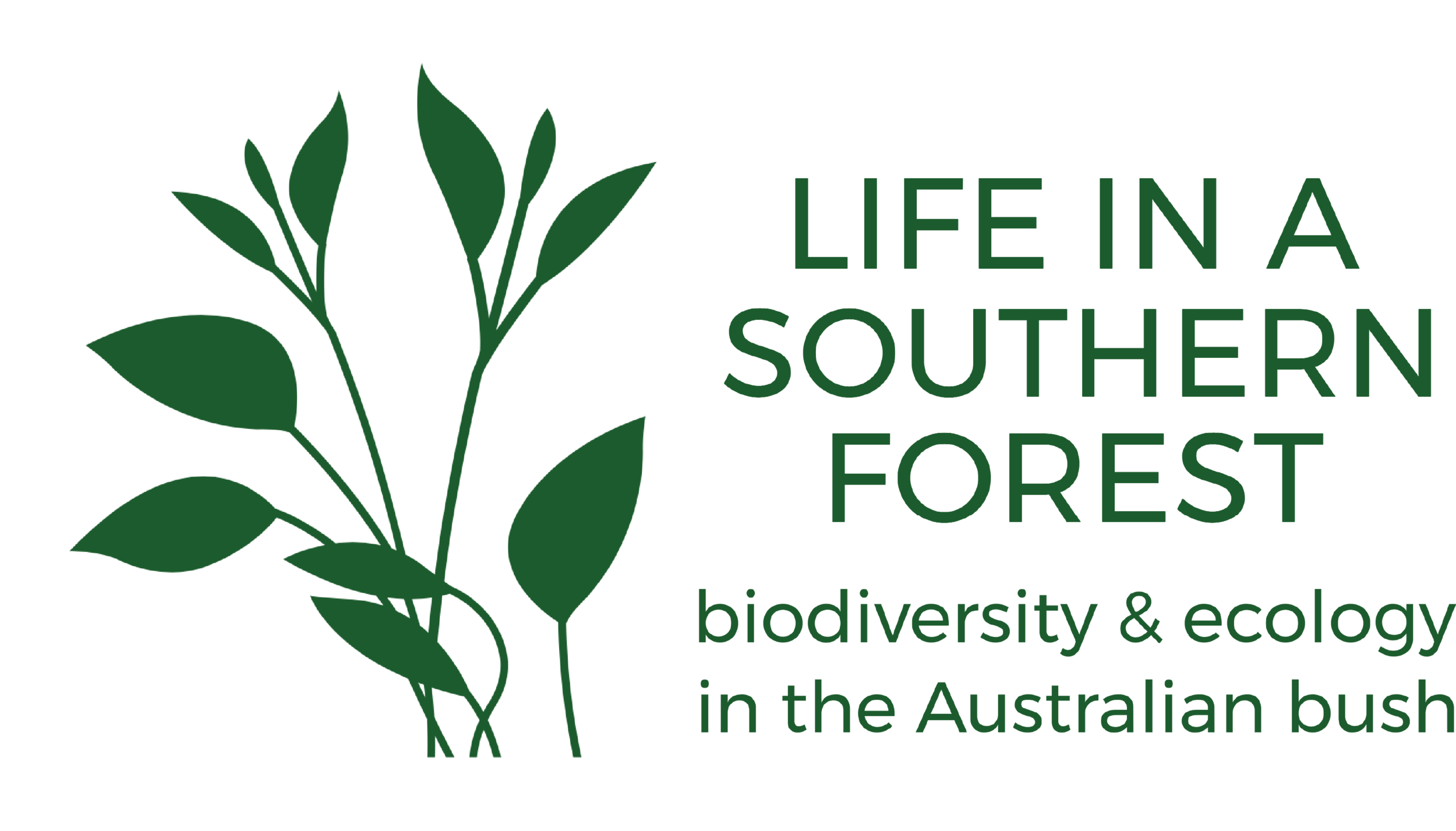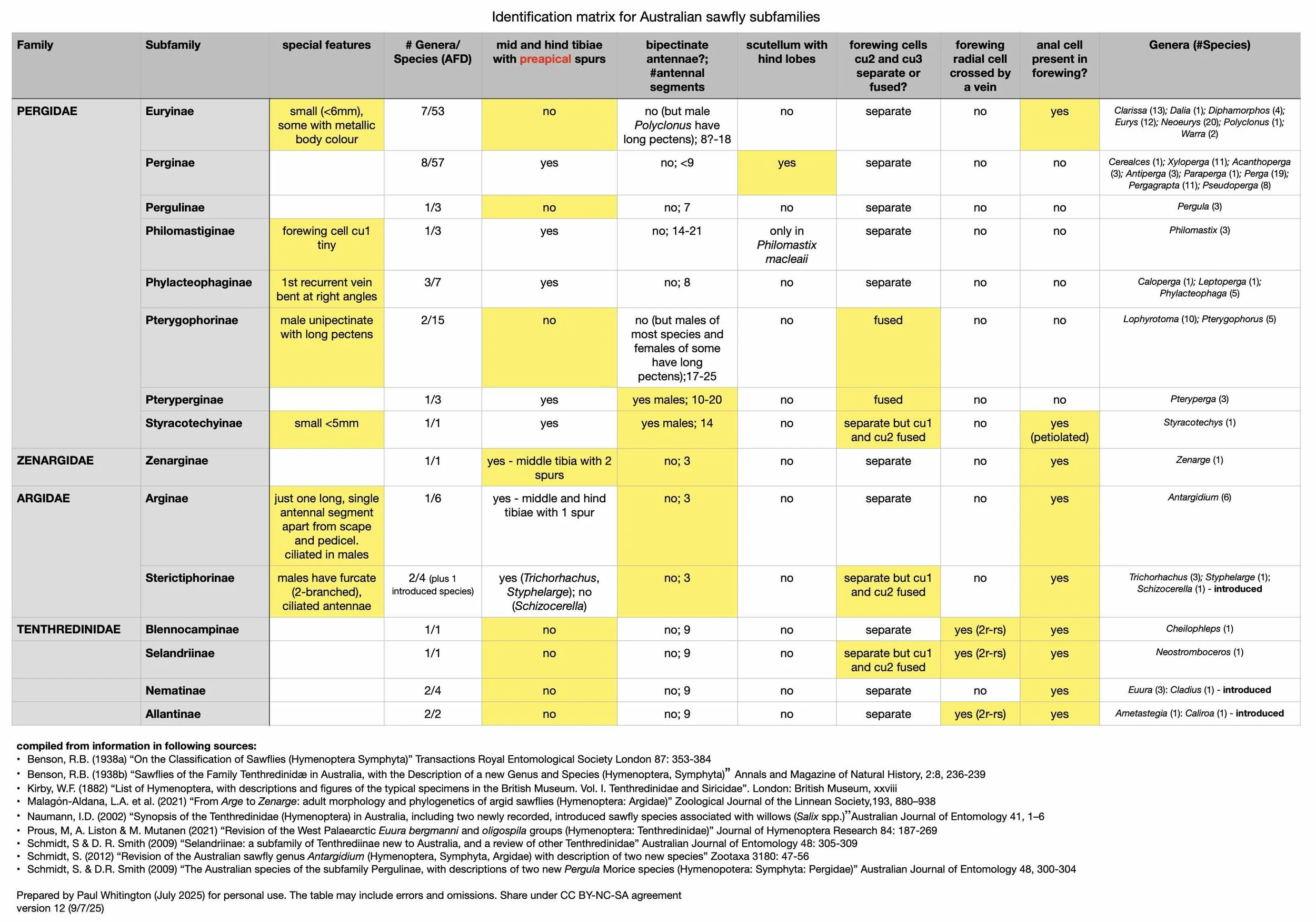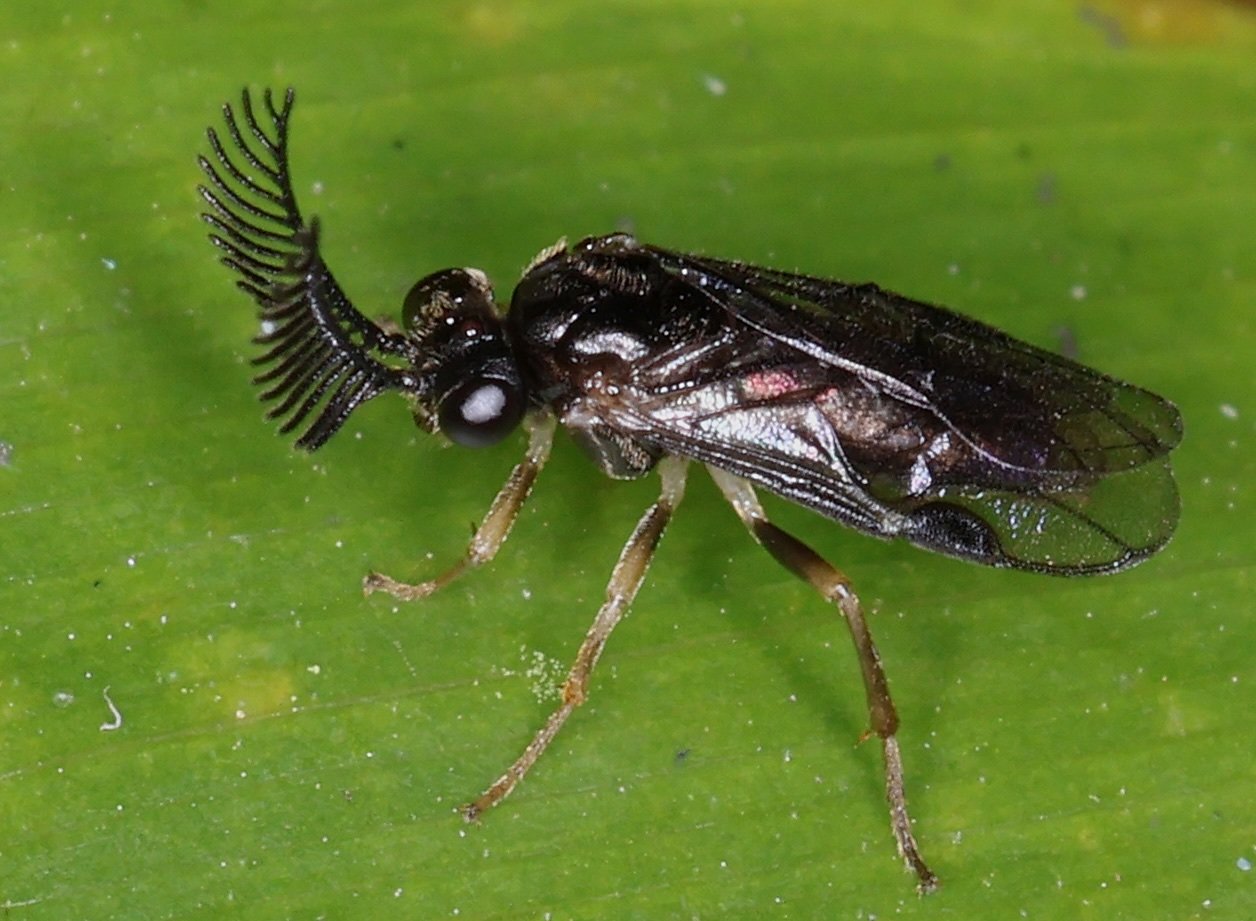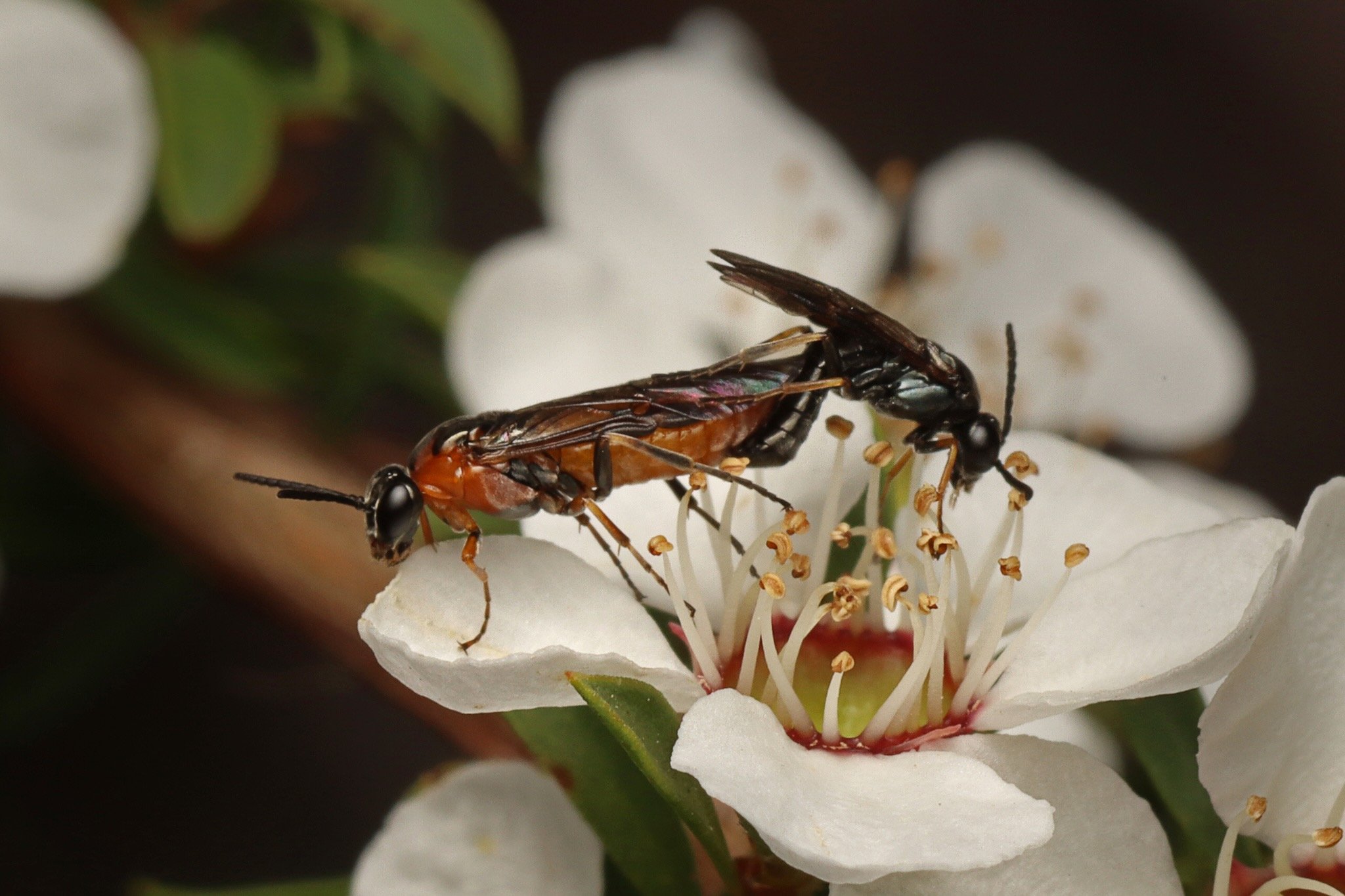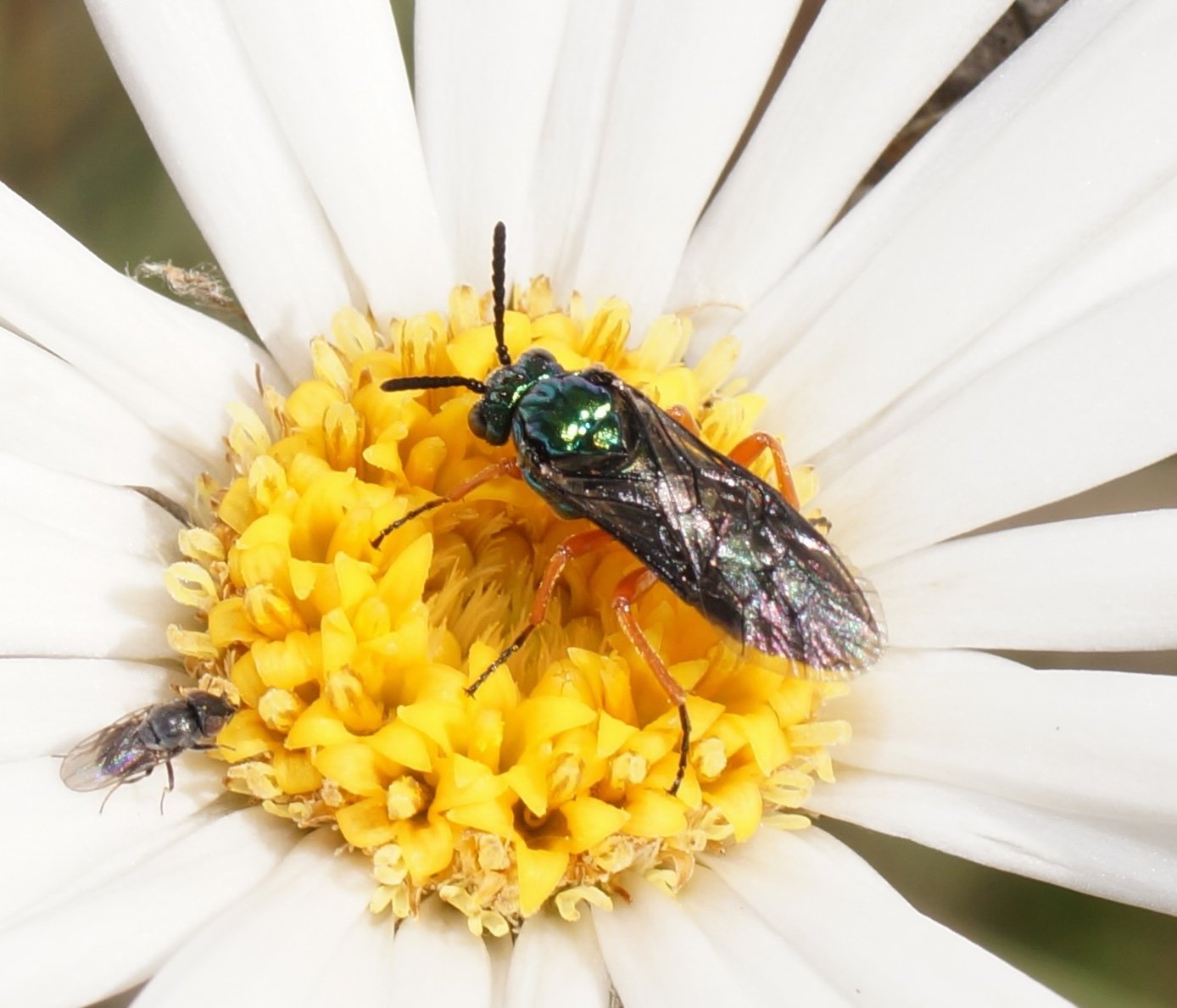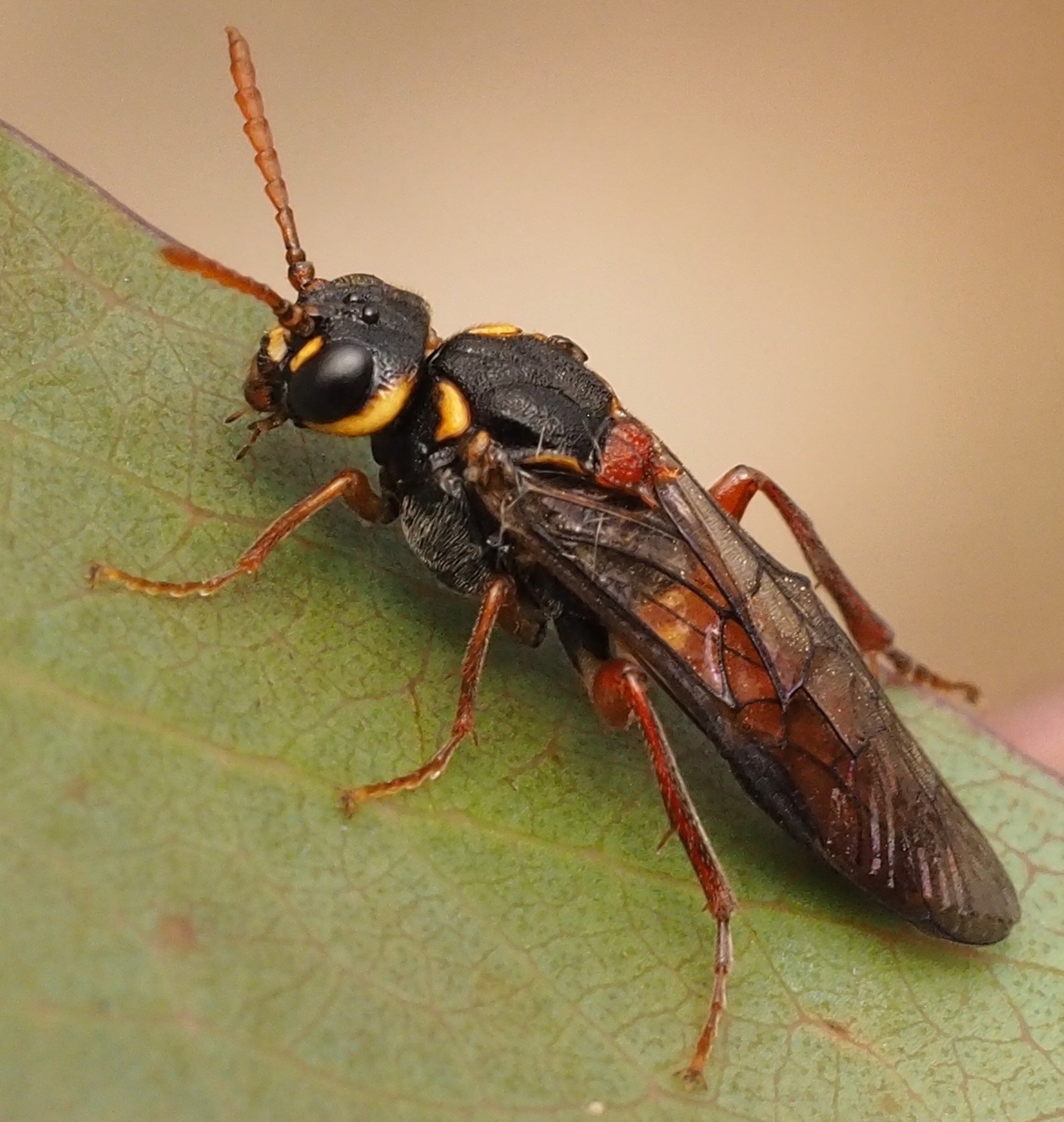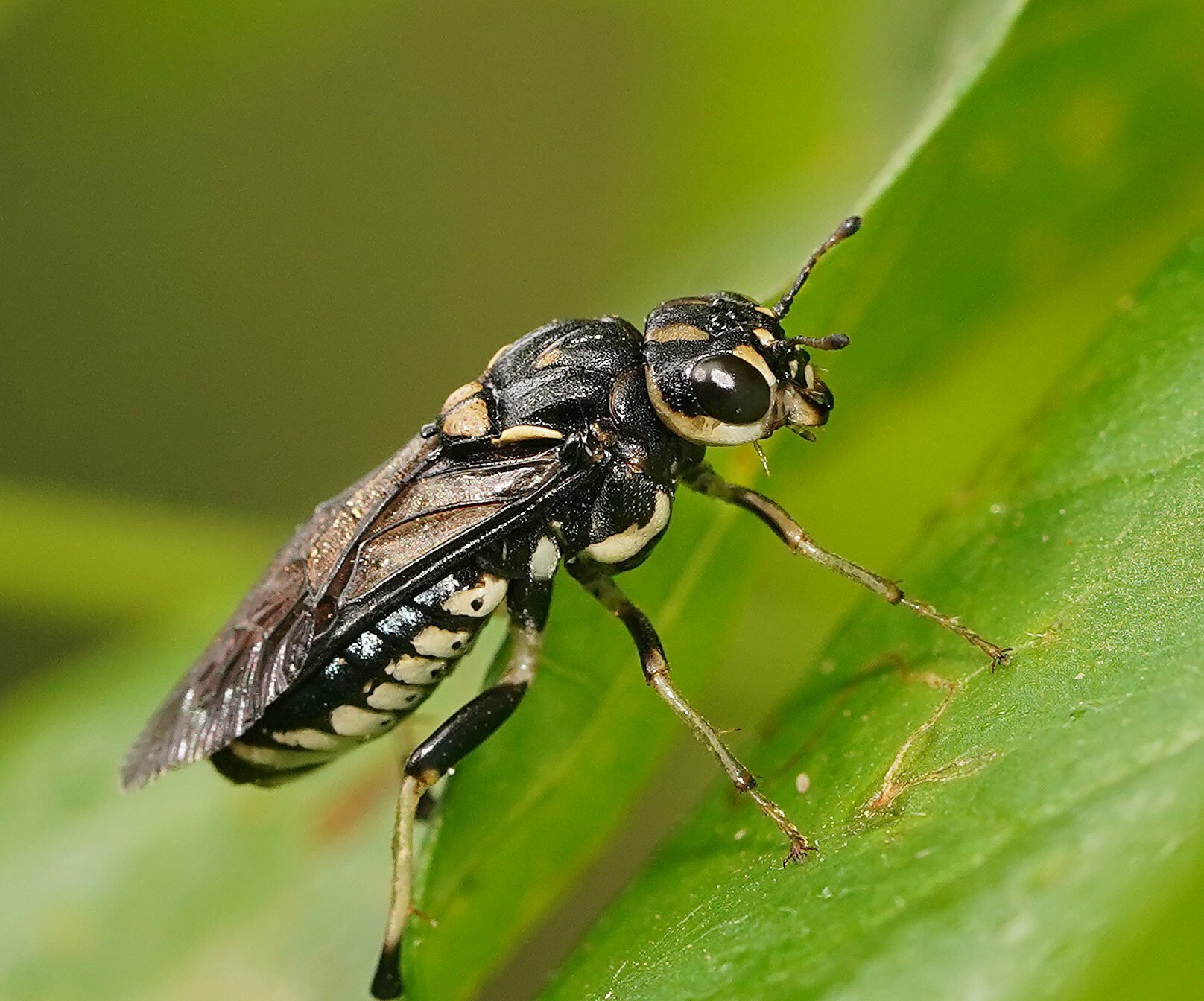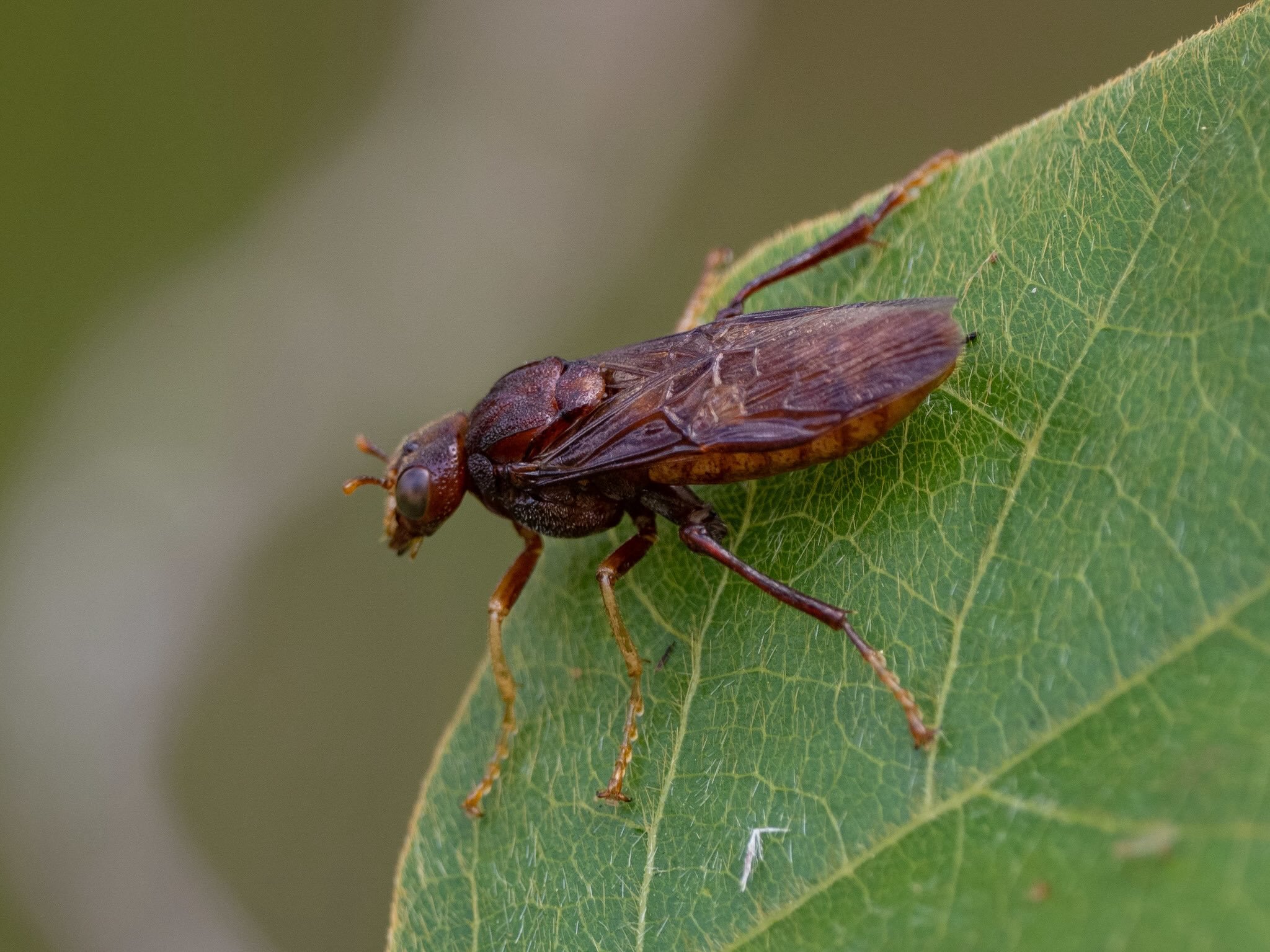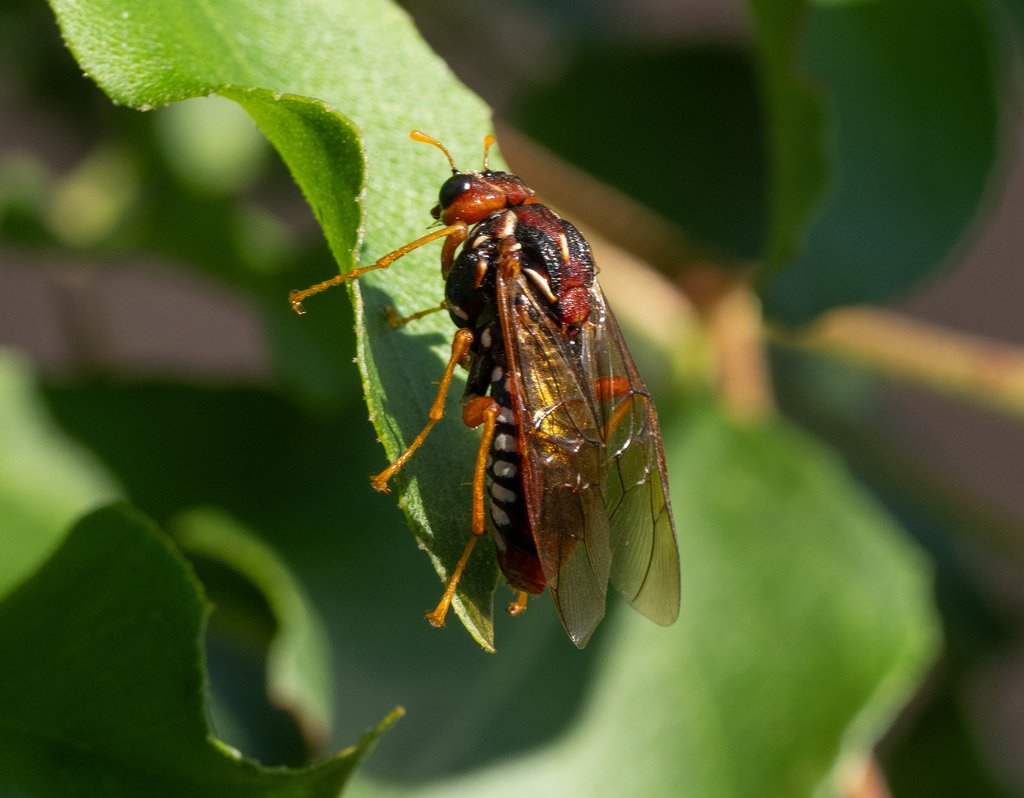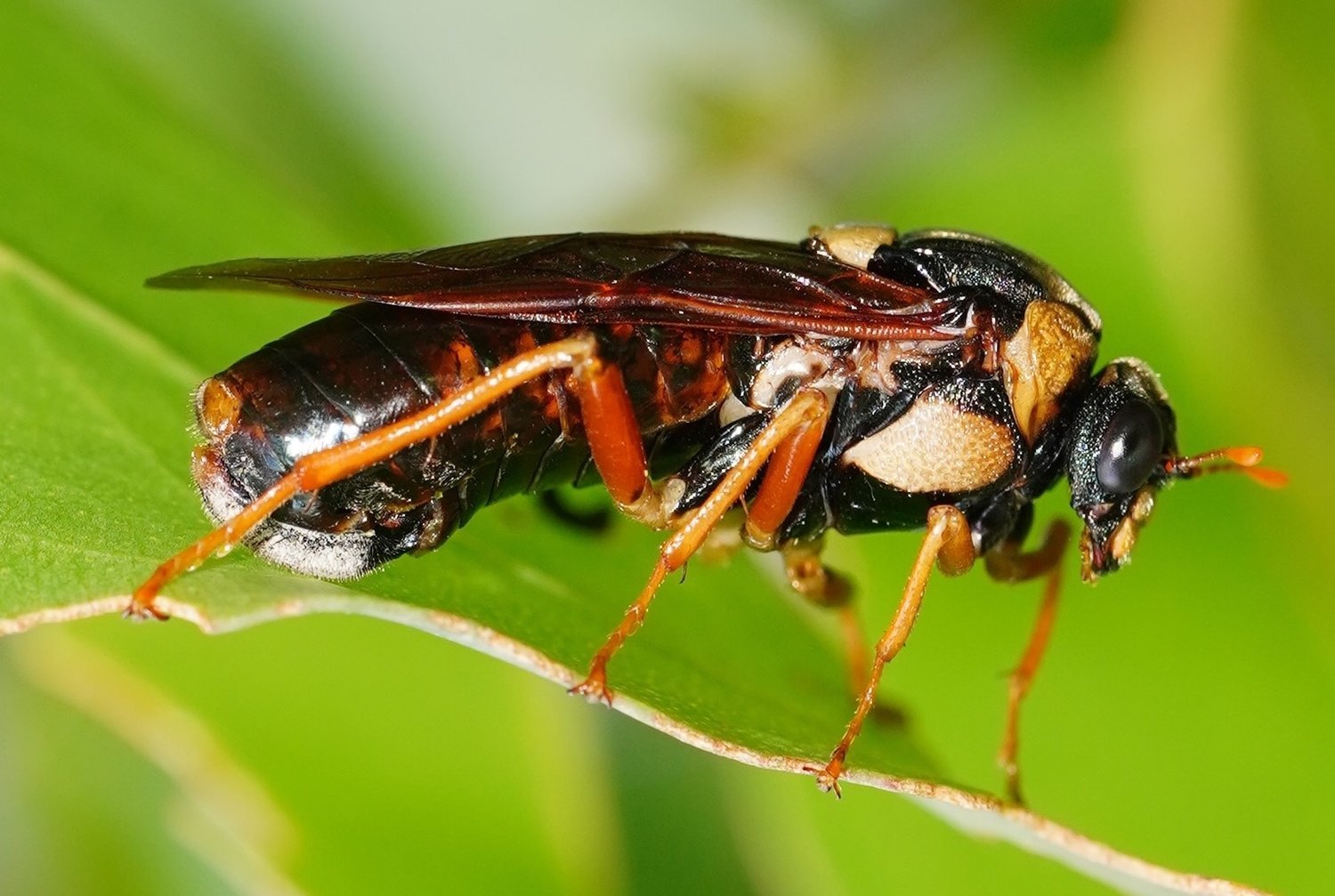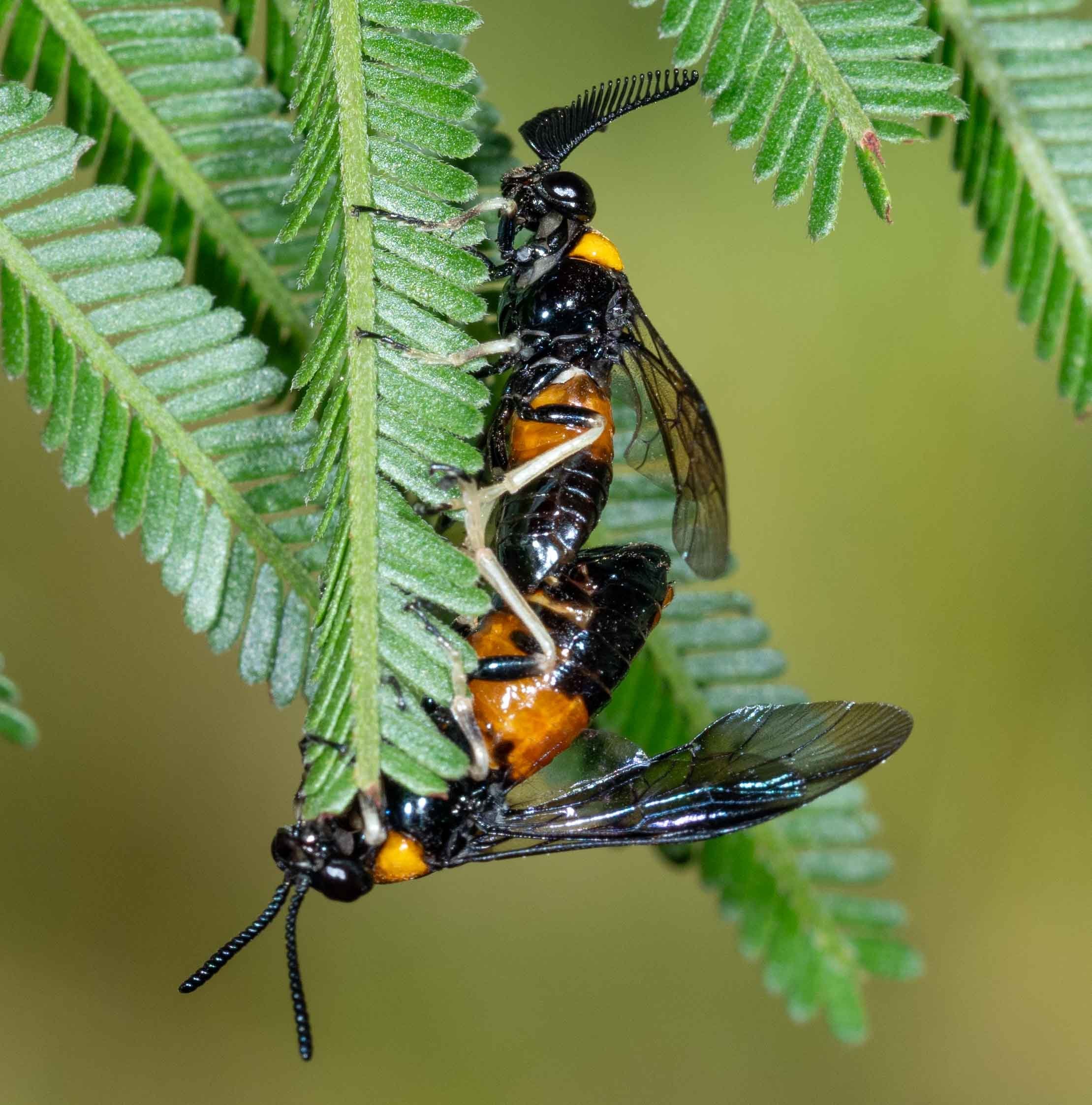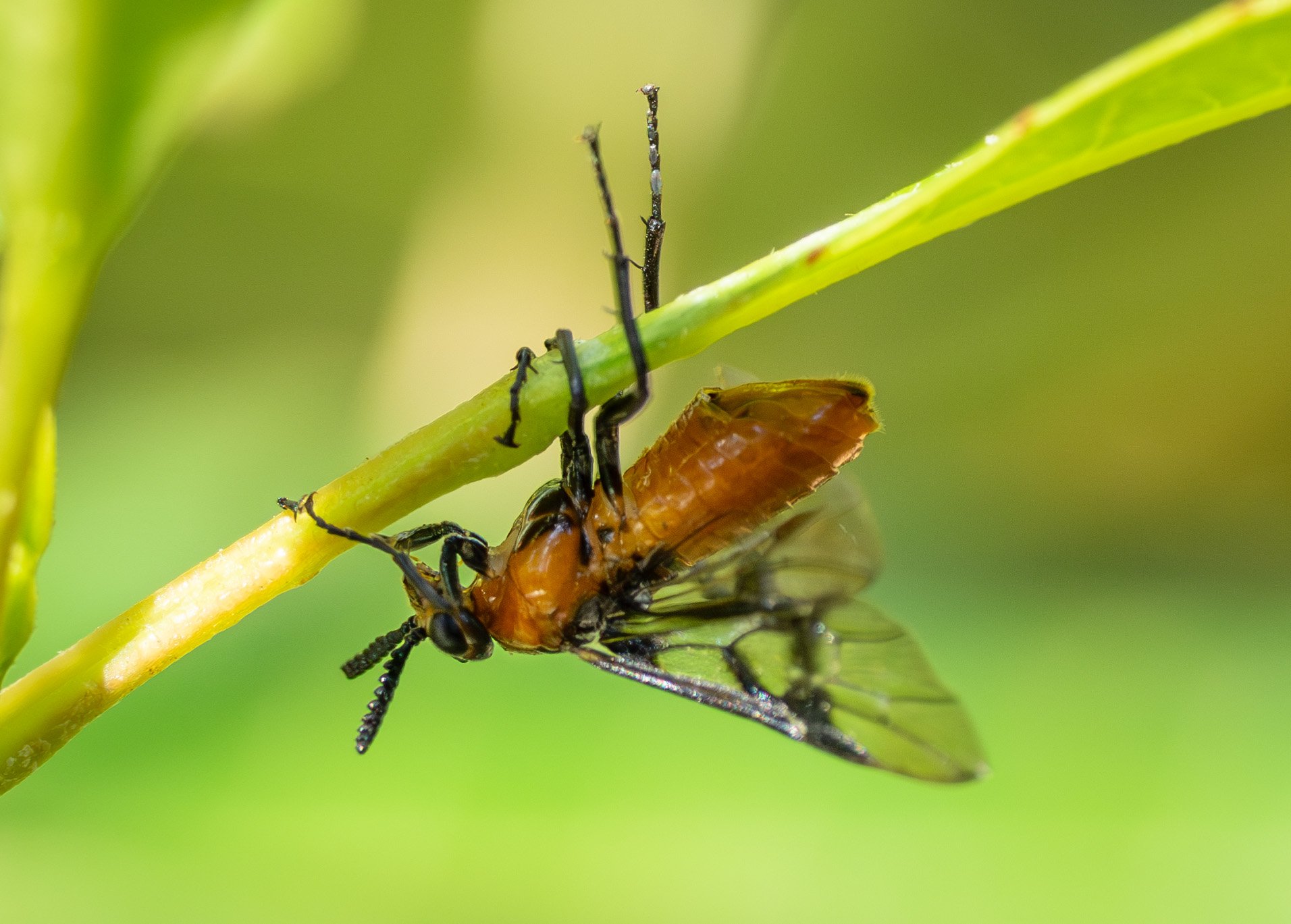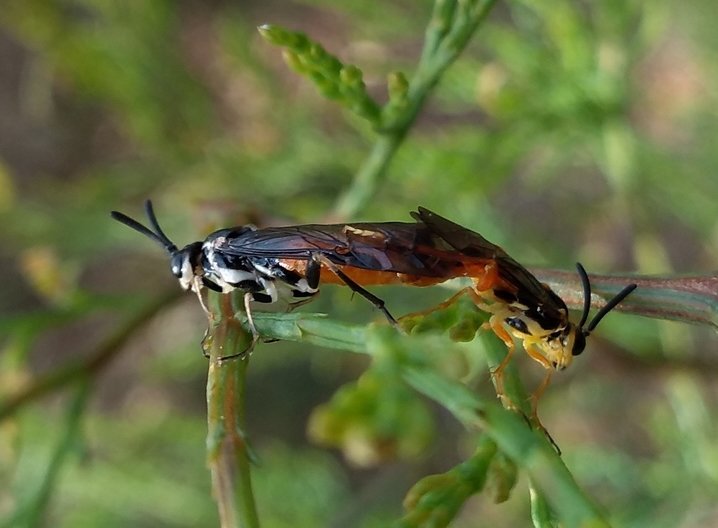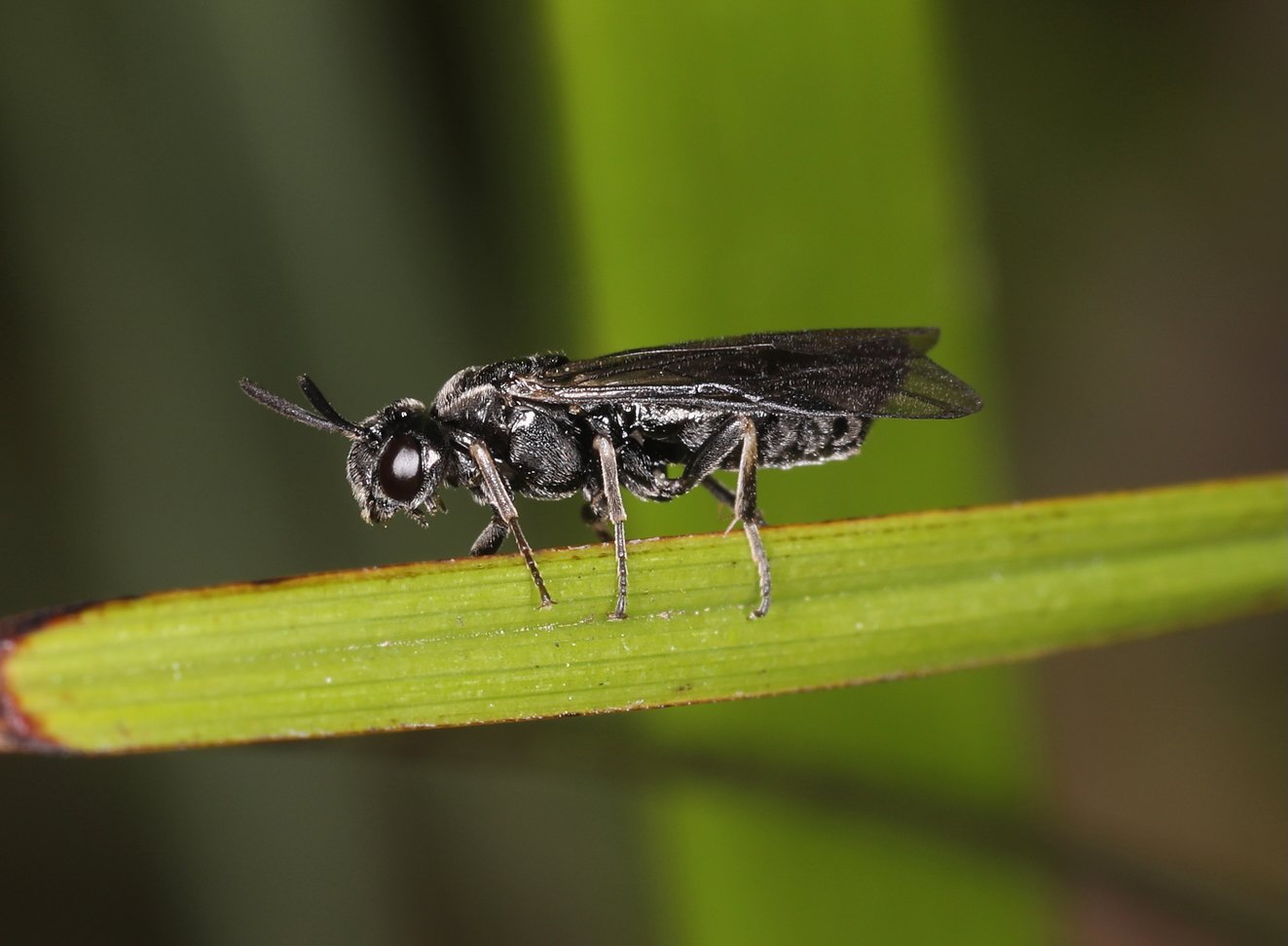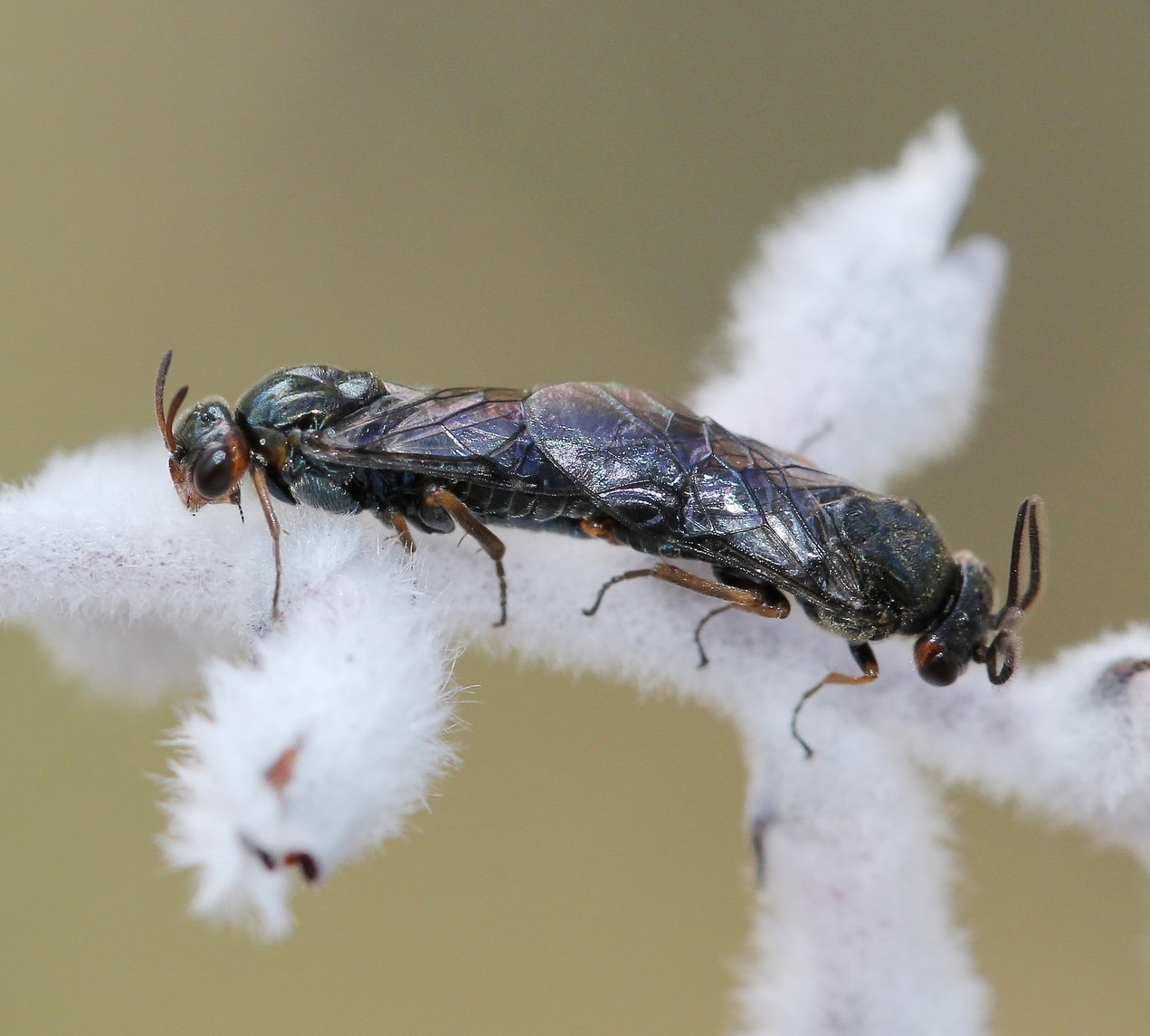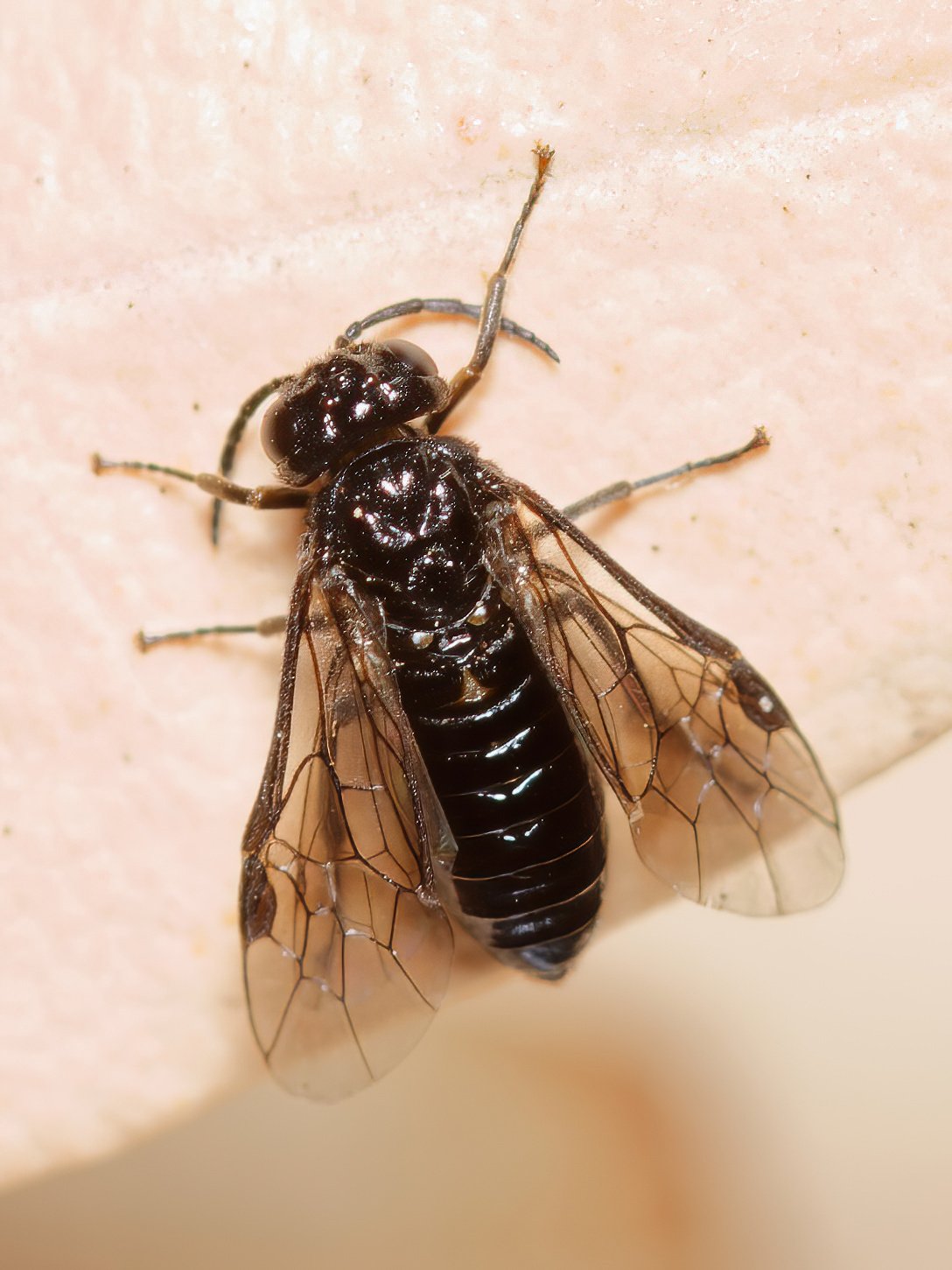Identifying Australian sawflies
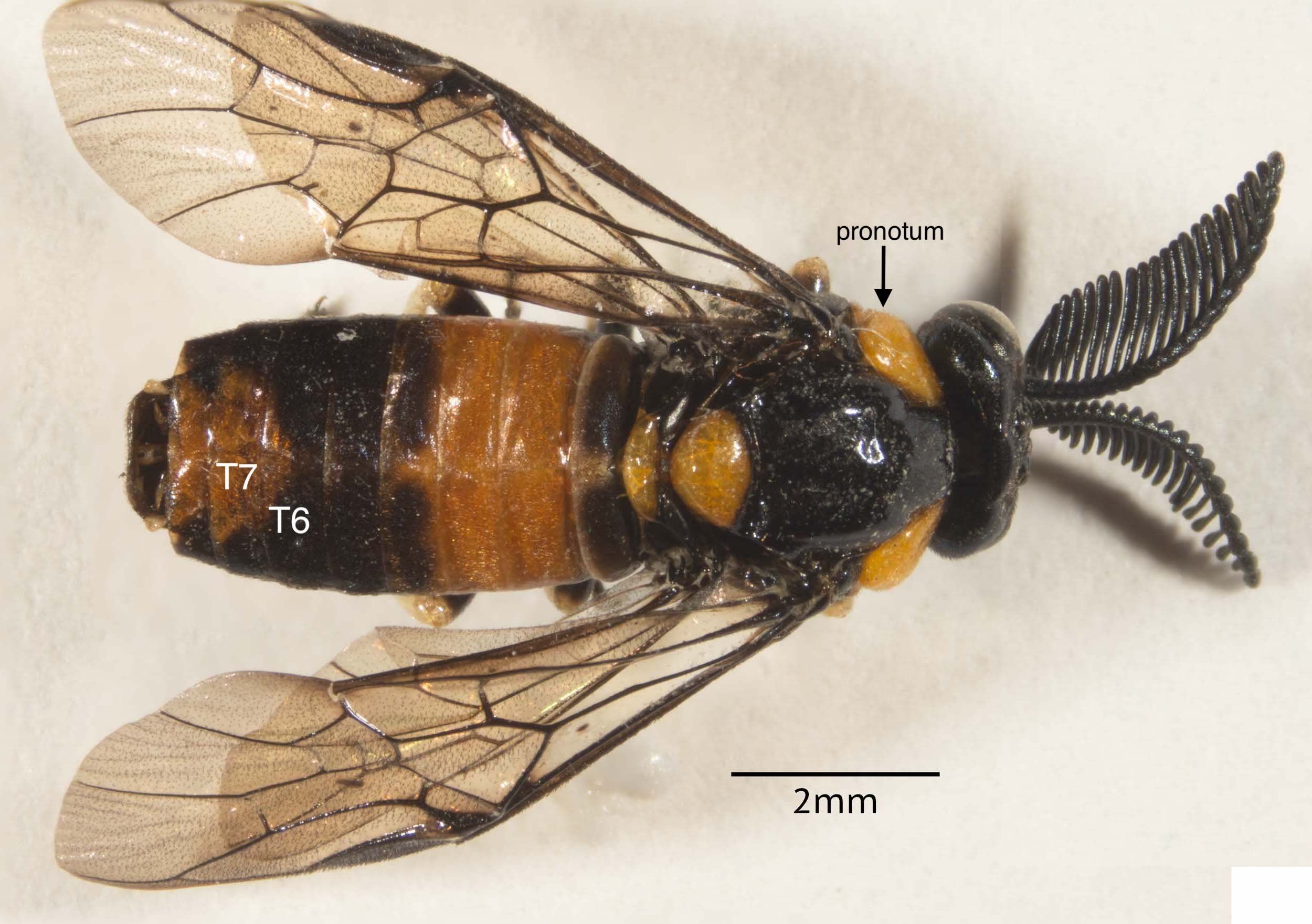
There is a dearth of resources for identification of Australian sawflies by the amateur naturalist. Accurate species identification generally requires a search of the primary literature, which, for a variety of reasons is only readily accessible to professional taxonomists.
To address this problem, I have developed a suite of resources to assist the identification of sawflies from photographs taken in the field or from an insect in the hand.
Labelled images of adult sawflies to aid recognition of various body parts, particularly those used in species descriptions.
The central tool used for species identification is the matrix - a table listing key distinguishing anatomical features of sawfly taxa at subfamily, genus and species levels. I have constructed these matrices using information in original descriptions and drawings and later taxonomic revisions in the primary literature - not from examination of iNaturalist photos.
The most recent catalogue of the Pergidae by Schmidt and Smith (2006) has greatly assisted the task of tracking down the scientific literature dealing with Australian sawflies.
Cautionary note: Many of the original species descriptions of Australian sawflies were based on examination of a limited number of specimens - often just the type specimen for that species. Consequently, they do not account for any possible intra-species variation. The degree of infuscation (dark colour) of head, thorax and legs is a common variable feature for certain species.
To allow quick navigation to the species ID page for a particular sawfly genus, I have provided a list of genera of all Australian sawflies. Each genus name is linked to its species ID page.
First, what I mean by a sawfly
For the purposes of these identification pages, I am defining sawflies as members of the superfamily Tenthredinoidea. This taxon includes four families of native Australian sawflies - Pergidae, Argidae, Zenargidae and Tenthredinidae. All members of these families have a saw-like ovipositor, from which they get their common name.
Another feature commonly used to separate sawflies from wasps is the lack of a waist. However, there are several superfamilies of wasps, related to the Tenthredinoidea, which share this same character. Two of these - Xiphydrioidea (wood wasps) and Orussoidea (parasitic wood wasps) - include Australian native species (14 Xiphydrioidea, 13 Orussoidea). I am not dealing with these here.
Body parts of adult sawflies
Of necessity, taxonomic papers contain many technical terms for describing the details of various body parts. Few people, apart from specialists in the field of study will be familiar with this jargon, making species descriptions difficult to interpret.
The aim of this section is to help the non-specialist reader become familiar with names of sawfly body parts. The following pair of drawings shows some of these. The sawfly illustrated, Aglaostigma quattuordecimpunctatum is a North American species, but the same naming system is used for Australian sawflies.
from Goulet & Huber 1993 “Hymenoptera of the World: An Identification Guide to Families”.
The Sawflies of Britain and Ireland website has an excellent illustrated glossary to sawfly body parts available for download here. These anatomical terms apply equally well to Australian sawflies.
The labelled photos which follow aim to help you recognise these and other body parts in the actual insect. I have used four different representative Australian sawfly species for this purpose – Lophyrotoma interrupta, a member of the subfamily Pterygophorinae, Pseudoperga ferruginea and Perga dorsalis, both members of the subfamily Perginae and Clarissa sp., a member of the Euryinae.
All of these images, with the exception of Figs. 4D, 6, 7 & 8 are either from this Workbook page on our blog or our own or other people’s iNaturalist sawfly observations (see attributions with photos).
Overall body structure & leg segments
Fig. 1 - Dorsal view of the female of Lophyrotoma interrupta. The terga (dorsal cuticular plates) T1-T8 of the abdomen, the thorax, the base of the head the fore and hind wings are visible.
Fig. 2 - Ventral view of same specimen showing names of leg segments.
Fig. 3 - segments of the hind tarsus in the same specimen
Wings - veins and cells
Fig. 4 - Names of veins and cells in fore wing of Lophyrotoma interrupta (A, B) and cells of Pseudoperga ferruginea (C) and Clarissa sp. (D). The wing venation is similar in these Pergidae species.
However, like all members of the subfamily Pterygophorinae, Lophyrotoma interrupta has 3 cubital cells, whereas Pseudoperga ferruginea, like all members of the subfamily Perginae, has 4.
The fore wing of Clarissa, like other members of the subfamily Euryinae, has an additional cell - anal cell - at the bottom edge of the wing.
Different naming systems - some of which are shown in this table - have been used for the wing veins and cells of sawflies over the years.
The wing terminology section of the glossary on the Sawflies of Britain and Ireland website has excellent diagrams showing wing cell and venation labelling (Figs.90-94).
Antennae
Fig. 5A. Lophyrotoma interrupta female
Fig. 5B. Lophyrotoma interrupta male
Fig. 5C. Pseudoperga ferruginea female
Fig. 5 - Sex and species differences in antennal structure. Lophyrotoma interrupta like other species in the subfamily Pterygophorinae has pectinated antennae. The pectens are much longer in the male than the female (compare A and B). Members of the subfamily Perginae, such as the female Pseudoperga ferruginea in C, have simple antennae, lacking pectens and with fewer segments. The last segment is often expanded to form a club in these sawflies. The total number of antennal segments - the number of repeating units in the flagellum plus the pedicel and the scape/funicle - is often given in species descriptions.
Parts of the head, thorax and abdomen
Fig. 6A. male Perga sp.
Fig. 6B. same specimen labelled
Fig. 6 - The side view of this male Perga sp. sawfly (either Perga dorsalis or Perga affinis) shows a number of structures that are often used in sawfly species descriptions.
The asterisks in Fig. 6B show a spine on the mid and hind tibiae, a feature of all subfamilies in the family Pergidae, except for Pterygophorinae and Euryinae.
Photo kindly provided by cgrant64 (CC BY-NC) from this iNaturalist observation.
Fig. 7A. female Perga sp.
Fig. 7B.
Fig. 7C.
Fig. 7D.
Fig. 7 - dorsal (A, B) and dorso-lateral (C, D) views of a female Perga sp. (probably Perga affinis) provide other views of key thoracic structures.
Photos kindly provided (CC-BY) by Reiner Richter from this iNaturalist observation.
Fig. 8A. Pergagrapta latreillii
Fig. 8B. Pergagrapta latreillii
Fig. 8C. Pergagrapta polita
Fig. 8D. Xyloperga lalage
Fig. 8 - lateral (A) and anterior (B) views of Pergagrapta latreillii, dorso-lateral view (C) of Pergagrapta polita and dorso-lateral view (D) of Xyloperga lalage showing further parts of the head and thorax.
Photos kindly provided (CC-BY) by Reiner Richter - A. & B. from this iNaturalist observation, C. from this one, and D. from this one.
Identification
There are 161 described species of Australian sawflies, distributed among 4 families – Pergidae, Argidae, Zenargidae & Tenthredinidae. How do you identify an individual sawfly within this large number of candidates?
First, which subfamily?
Find the row in the matrix below that is the best match to the combination of features in that sawfly. All of the structures referred to in this matrix are shown in photos in the “Body Parts of Adult Sawflies” section above. You don’t need to see all of these features - only enough of them to place that insect in one of the subfamilies.
Footnote:
Bear in mind that this taxonomic framework - like all taxonomy - is subject to review. A genus that is currently placed in a particular subfamily may later be shown to be more closely related to a different subfamily, or indeed a different family.
Second, which genus and species?
Under each of the subfamily headings below (grouped by families) you will find a matrix to help you determine the genus, followed by a link which deals with that genus. This page includes:
diagnostic features of that genus or genera
a matrix for identifying species in those genera
links to iNaturalist Research Grade observations of those species
images of individual species from ‘authoritative’ sources, viz.:
drawings from original descriptions or later revisions of species in the taxonomic literature
photos of type specimens in museums
photos of BOLD (Barcode of Life Data Systems) specimens
These images do not include photos from iNaturalist, as the ‘authoritative’ images will be used together with the matrices to aid identification of sawflies in iNaturalist observations.
You may want to return to this page from linked pages. To do so, click on the BACK TO SAWFLY HUB button at the top of those pages.
PERGIDAE
Euryinae
There are 7 genera in the subfamily Euryinae. Use this matrix to find your genus.
Then use the appropriate page from the row below to identify your species.
Perginae
There are 8 genera in the subfamily Perginae. Use this matrix to find your genus.
Then use the appropriate page from the row below to identify your species.
Pterygophorinae
There are only 2 genera in the subfamily Pterygophorinae - Lophyrotoma and Pterygophorus. This page shows a matrix for each of these genera.
Use these matrices to find your species.
Other Pergidae subfamilies
There are a further 7 genera across the remaining 5 subfamilies of the Pergidae. This page shows a matrix for each of these subfamilies.
Use the appropriate matrix to find your species.
ZENARGIDAE
Zenarginae
There is only one genus in the subfamily Zenarginae, which has only a single species - Zenarge turneri.
ARGIDAE
Arginae
Antargidium is the only genus in the subfamily Arginae.
Use the matrix on this page to find a match among its 6 species.
Sterictiphorinae
This subfamily includes 5 species across 3 genera.
Use the matrix on this page to find a match among these 5 species.
TENTHREDINIDAE
Blennocampinae, Selandriinae, Nematinae & Allantinae
Use the descriptions and images (where available) on this page to find a match amongst the 8 species in this family.
Quick links to genera
Click on a genus name to navigate to the species ID page for that genus:
References:
Benson, R.B. (1938) “On the classification of sawflies (Hymenoptera Symphyta)” Transactions Royal Entomological Society London 87: 353-384
Benson, R.B. (1938) “A revision of the genus Pterygophorus Klug, sensu lato, with the description of two new genera (Hymenoptera, Symphyta)”. Annals and Magazine of Natural History 1:610-625
Costa, A. (1864) “Aeguisti fatti durante l'anno 1862”. Annuario del Museo Zoologico della Reale Universitá di Napoli 2: 8-138.
Goulet, H. & Huber, J. T. eds. (1993). “Hymenoptera of the world: an identification guide to families”. Research Branch, Agriculture Canada Publication 1894/E. freely available from a variety of sources including https://doi.org/10.1002/mmnd.19950420212
Kirby, W.F. (1882) “List of Hymenoptera, with descriptions and figures of the typical specimens in the British Museum”. Vol. I. Tenthredinidae and Siricidae. London: British Museum, xxviii Biodiversity Heritage Library link
Konow, F.W. (1905) “Familie Tenthredinidae”. In Wytsman, P., Genera Insectorum. Fasc. 29
Leach, W.E. (1817) “The zoological miscellany; being descriptions of new, or interesting animals. Vol. 3”. Shoe-Lane, London: R. and A. Taylor. Biodiversity Heritage Library link
Morice, F.D. (1918) “Notes on Australian sawflies, especially the “Authors' Types” and other specimens in the British Museum of Natural History and the Hope Collections of the Oxford University Museum; with diagnostic synopses of the genera and species, and photographs illustrating their structural characters”. Transactions of the Entomological Society of London 66: 247-333 Biodiversity Heritage Library link
Rohwer, S.A. (1910) “Some Australian Sawflies” Entomological News 21:467-474
Schmidt, S. & Smith, D.R. (2006) “An annotated systematic world catalogue of the Pergidae (Hymenoptera)” Contributions of the American Entomological Institute 34 (3), 207 pp.
Schmidt, S. & Walter, G.H. (2014) “Young clades in an old family: Major evolutionary transitions and diversification of the eucalypt-feeding pergid sawflies in Australia (Insecta, Hymenoptera, Pergidae)” Molecular Phylogenetics and Evolution 74: 111-121
This is a workbook page … a part of our website where we record the observations and references used in making species identifications. The notes will not necessarily be complete. They are a record for our own use, but we are happy to share this information with others.
